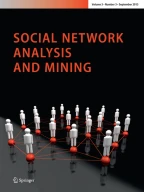Abstract
Traditional network generation models aim to replicate global structural properties observed on various real-world networks through synthetic link formation mechanisms such as triadic closure or preferential attachment. Nowadays, the large amount of data available allow to study more precisely the link formation processes and to compare models with real situations. In this work, we analyze the network formed by the communication activities of the users of a telephony operator for studying the link formation process. Our goal is to identify the underlying formation mechanisms and checking if they match those proposed in traditional models. Indeed, the communications emitted and received by users are strong indicators for understanding the underlying patterns of the link formation process and highlighting how some individual properties induce the formation process in such a network. In a first study conducted at a global level, we show that the traditional mechanisms commonly used in network generation models cannot reproduce alone the link formation in this network. In a second study, we adopt a new point of view and analyze locally the link formation process by searching for correlations between some user attributes and the formation of the new links. The results obtained show that a very strong percentage of new links are formed between individuals with strong similarity.
Similar content being viewed by others
References
Amaral LAN, Scala A, Barthelemy M, Stanley HE (2000) Classes of small-world networks. Proc Natl Acad Sci 97(21):11149–11152
Barabasi A, Albert R (1999) Emergence of scaling in random networks. Science 286(5439):509–512
Barabasi AL (2002) Linked: The New Science of Networks. Perseus Books
Barabasi AL (2009) Scale-free networks: a decade and beyond. Science 325(5939):412–413
Barclay VC, Smieszek T, He J, Cao G, Rainey JJ, Gao H, Uzicanin A, Salathe M (2014) Positive network assortativity of influenza vaccination at a highschool: implications for outbreak risk and herd immunity. PLoS One 9(2):e87042
Boccaletti S, Latora V, Moreno Y, Chavez M, Hwang DU (2006) Complex networks: structure and dynamics. Phys Rep 424(4):175–308
Boguna M, Pastor-Satorras R, Diaz-Guilera A, Arenas A (2003) Emergence of clustering, correlations, and communities in a social network model. Arxiv preprint cond-mat 0309263
Borner K, Sanyal S, Vespignani A (2007) Network science. Blaise Cronin (Ed) Ann Rev Inf Sci Technol 41:537–607
Chang S, Kumar V, Gilbert E, Terveen LG (2014) Specialization, homophily, and gender in a social curation site: findings from pinterest. In: Proceedings of the 17th ACM conference on Computer supported cooperative work and social computing, ACM, pp 674–686
Chin A, Xu B, Yin F, Wang X, Wang W, Fan X, Hong D, Wang Y (2012) Using proximity and homophily to connect conference attendees in a mobile social network. In: Distributed Computing Systems Workshops (ICDCSW), 2012 32nd International Conference on, IEEE, pp 79–87
Collard M, Collard P, Stattner E (2012) Mobility and information flow: percolation in a multi-agent model. In: 3rd international conference on ambient systems, networks and technologies
Collard M, Collard P, Stattner E (2013) Simulating human mobility and information diffusion. In: Advances in Social Networks Analysis and Mining 2013, ASONAM’13, Niagara, ON, Canada- August 25 - 29, 2013, IEEE/ACM, pp 197–201
Davidsen J, Ebel H, Bornholdt S (2002) Emergence of a small world from local interactions: modeling acquaintance networks. Phys Rev Lett 88(12):128701
Dorogovtsev SN, Mendes JFF (2002) Evolution of networks. Adv Phys 51(4):1079–1187
Fortunato Santo (2009) Community detection in graphs. Phys Rep 486:75–174
Guimera R, Danon L, Diaz-Guilera A, Giralt F, Arenas A (2002) Self-similar community structure in organisations. Arxiv preprint cond-mat/0211498
Kossinets G, Watts DJ (2006) Empirical analysis of an evolving social network. Science 311(5757):88–90
Kumpula JM, Onnela JP, Saramäki J, Kaski K, Kertész J (2007) Emergence of communities in weighted networks. Phys Rev Lett 99(22):228701
Leskovec J, Backstrom L, Kumar R, Tomkins A (2008) Microscopic evolution of social networks. In: Proceedings of the 14th ACM SIGKDD international conference on Knowledge discovery and data mining, ACM, pp 462–470
Lewis Kevin, Gonzalez Marco, Kaufman Jason (2012) Social selection and peer influence in an online social network. Proc Natl Acad Sci 109(1):68–72
Lieberman S, Alt JK (2010) Developing social networks for artificial societies from survey data. In: Advances in Social Computing, Springer, pp 159–168
Marsili M, Vega-Redondo F, Slanina F (2004) The rise and fall of a networked society: a formal model. Proc Natl Acad Sci USA 101(6):1439
McPherson M, Smith-Lovin L, Cook JM (2001) Birds of a feather: homophily in social networks. Annu Rev Sociol 27(1):415–444
Milgram S (1967) The small world problem. Psychol Today 1:61–67
Newman MEJ (2003) The structure and function of complex networks. SIAM Rev 167–256
Opsahl T (2011) Triadic closure in two-mode networks: redefining the global and local clustering coefficients. Soc Netw 35(2):159–167
Siobhan K (2014) Young, Robert H Lyles, Lawrence L Kupper, Jessica R Keys, Sandra L Martin, and Elizabeth C Costenbader. Assortativity coefficient-based estimation of population patterns of sexual mixing when cluster size is informative. Sex Trans Infect 90(4):332–336
Stattner E , Collard M (2012) Max-flmin: an approach for mining maximal frequent links and generating semantical structures from social networks. In: 23rd International Conference on Database and Expert Systems Applications
Stattner E, Collard M, Vidot N (2012) D2snet: dynamics of diffusion and dynamic human behaviour in social networks. Comput Hum Behav
Toivonen R, Kovanen L, Kivela M, Onnela JP, Saramaki J, Kaski K (2009) A comparative study of social network models: network evolution models and nodal attribute models. Soc Netw 31
Toivonen Riitta, Onnela Jukka-Pekka, Saramäki Jari, Hyvönen Jörkki, Kaski Kimmo (2006) A model for social networks. Phys A Statis Mech Appl 371(2):851–860
Vázquez Alexei (2003) Growing network with local rules: Preferential attachment, clustering hierarchy, and degree correlations. Phys Rev E 67(5):056104
Watts DJ, Strogatz SH (1998) Collective dynamics of ’small-world’ networks. Nature 393:440–442
Author information
Authors and Affiliations
Corresponding author
Rights and permissions
About this article
Cite this article
Stattner, E. Involvement of node attributes in the link formation process into a telecommunication network. Soc. Netw. Anal. Min. 5, 64 (2015). https://doi.org/10.1007/s13278-015-0304-y
Received:
Revised:
Accepted:
Published:
DOI: https://doi.org/10.1007/s13278-015-0304-y
